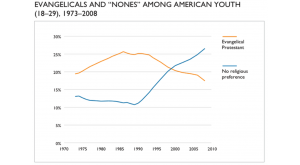In Practice in Christianity, Kierkegaard writes this:
Let us look at him and his life; let us speak altogether humanly about it; he was, after all, truly human. He began his life in lowliness, led his life in lowliness and abasement to the very end, then ascended on high–what does this mean? It means that temporality in its entirety was suffering and abasement; not until eternity is there victory, loftiness. Therefore it is not like what one ordinarily sees at times in the life of a person who perhaps for a few years finds himself in lowliness and abasement, endures misjudgment and persecution, but then, still within the bounds of temporality, is victorious and rises to the heights. No, he ended as he began; born in poverty as if he were scarcely a human being (only in a stable was room found for the baby); he ended, as if he were scarcely a human being, with that ignominious death, crucified like a criminal–and only then did he ascend on high.
Kierkegaard goes on a few paragraphs later to warn us that, if we would be “contemporary” with Christ, if we would draw near to the Christ who calls us from on high, we must not assume that we can begin where he ended (in a situation of “loftiness.” Rather, we must follow the prototype (Christ) through lowliness and abasement. This is Kierkegaard’s theology of the cross. This cuts against the way we so often want Christianity to be–the way we often present it. But on this day and tomorrow, it is good to take Kierkegaard’s suggestion seriously: “Since it is indeed from on high that he is drawing you, illusion lies all too close.”











